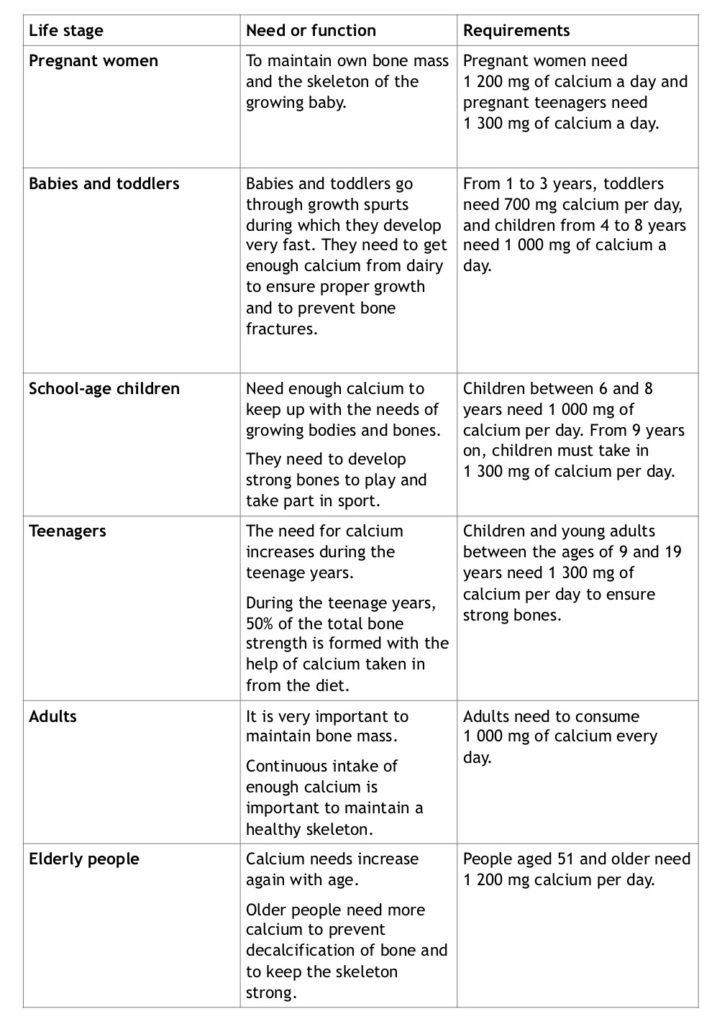All growing children need good nutrition to build healthy bodies. Eating patterns that are formed while growing up influence dietary patterns throughout life and is a good prediction of overall health in adulthood. Therefore it is important that parents should not only strive to feed their children a healthy balanced diet, consisting of a variety of foods, but also set a good example by eating healthy food themselves.
Maretha Vermaak, registered dietitian at Rediscover Dairy says: “Growing children need vital nutrients, including those found in dairy foods, to help them develop strong, healthy bodies. It is important to make sure that children are not at risk. Hunger and poor nutrition are not only connected to their growth and development, but also their readiness to learn. When children have regular access to nutritious meals, especially breakfast, research shows a connection to better performance in school.”
Everyone in the family needs dairy in every stage of their life
It starts at pregnancy. Because dairy is important for bone health and development, it is important for a pregnant mother. When a woman expects a baby, she needs to make sure that she gets enough calcium to maintain her own bone mass and the skeleton of her growing baby. Healthy, sensible eating and planning are necessary to give your body and the growing baby everything needed for a healthy outcome. Dairy will help provide you and your baby with many of the important nutrients you need.
Your daily calcium needs during the life cycle
Your baby grows very fast in the first year of life:
- Birth weight triples
- Length increases by 50%
- Head circumference increases by 30%
- The percentage of water in the body decreases, whereas the percentage of fat and protein increases
- At one year of age, your baby should have at least developed four teeth
It is well recognised that the period from birth to two years of age is a ‘critical window’ for the promotion of optimal growth, health, and behavioural development. Breastfeeding your baby is the best start for any child. Breast milk helps keep your baby healthy and it supplies all the necessary nutrients in the proper proportions. It also protects your baby against allergies, sickness, and child obesity. Breast milk is the perfect food for your baby – it changes constantly to meet babies’ needs. The milk volume and composition changes according to the time of day, nursing frequency, and the age of the baby to promote healthy growth. The World Health Organisation encourages exclusive breastfeeding for the first six months of life.
By the age of six months, your baby is now ready to be introduced to solid foods. This is the time to start with complementary feeding.
Complementary feeding is defined as the process starting when breast milk alone is no longer enough to meet the nutritional requirements of infants, and other foods and liquids are needed in addition to breast milk.
When you introduce your baby to solids, start with small amounts of one food at a time and increase the quantity as the child gets older.
Examples of introductory foods include:
- soft maize meal porridge;
- iron-fortified rice cereal;
- sweet potatoes or potatoes;
- butternut and other mashed or strained vegetables;
- chicken livers or fine, soft meat or chicken; and
- mashed fruit like bananas or pawpaw.
Subsequently, a variety of foods is recommended.
This is also the ideal time to introduce yoghurt and cheese to your child. Yoghurt is a perfect base for lunch or an in-between snack. You can mix plain full-cream or double cream yoghurt with fresh mashed fruit. Remember your baby does not know the taste of sugar or salt and you do not need to add any sugar or use sweetened yoghurt. You can grate cheese into their vegetables or allow them to eat a piece of cheese just like that – it is a perfect finger food. Full-cream milk may also be used to mix their cereal or in a white sauce as an addition to vegetables. Adding milk to your baby’s food ensures the addition of many important nutrients and good quality protein.
At the age of six months your baby still needs breast milk and mothers are strongly advised to continue breastfeeding. If possible, breastfeeding should continue up to two years. At six months your baby still needs 150 ml milk per kilogram of body weight. Acceptable milk sources include fresh full-cream milk, long-life milk (UHT), fermented milk (maas), or yoghurt.
Increase the consistency and variety of food gradually as the infant gets older, adapting to the baby’s requirements and abilities. Infants can eat pureed, mashed, and semi-solid foods from six months of age. By eight months, most babies can also eat ‘finger foods’, which is food that they can eat on their own. By 12 months, most children can eat the same types of foods as the rest of the family. However, keep in mind the need for foods rich in nutrients.
It is important to teach children from an early age to enjoy their food. Mealtimes should be times of relaxed social interaction in a loving environment.
How and when to introduce dairy in your child’s diet

There is a dairy product to suit everyone’s taste and dietary preferences.
- Why dairy for all-day focus and energy - May 28, 2025
- The power of dairy nutrition for active teenagers - September 19, 2024
- Why dairy has a significant place in sustainable diets - June 7, 2024





